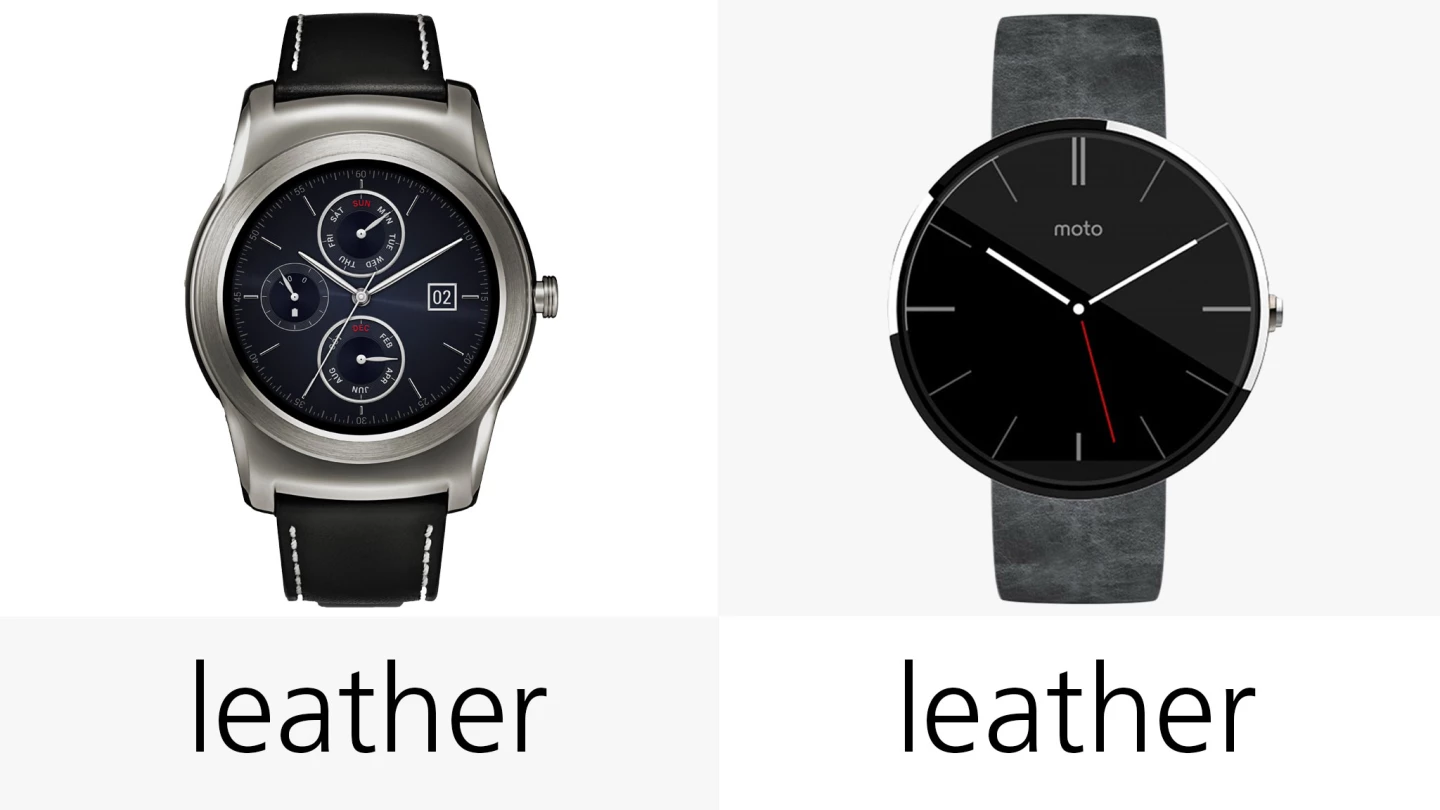LG made one of the best smartwatches of 2014, in the G Watch R. Now the company is back with an all-metal variant called the LG Watch Urbane (no "G" this time around). Let's compare its features and specs to those of the Moto 360.
Software

These are both Android Wear watches, and since Google doesn't allow custom skins, their software is basically identical. The only differences are add-on apps, like Motorola's Connect app.
Android Wear is great at voice control, notifications (including contextual info via Google Now) and basic fitness tracking. It doesn't, however, go far beyond those areas right now.
Size

Looking at the watches' bodies, the Watch Urbane is 13 percent taller and just about the same width as the Moto 360. The Urbane is also about 5 percent thinner than Motorola's flagship (though the Urbane is actually a little thicker than the G Watch R).
Weight

LG hasn't yet listed the weight of the Watch Urbane. Unless it's sitting at an unusual extreme, though, this probably isn't anything to worry about.
Build

That new all-stainless steel body is the LG Watch Urbane's big upgrade. Apart from the fashionable makeover, it also has a cleaner look than the G Watch R (it loses the diver watch markings).
Though most of the Moto 360's body is made of stainless steel, its wrist-facing backside is made of plastic.
Physical buttons

Each of these watches only has one physical button, mostly for powering on and off (you can also long-press it for a menu shortcut).
Colors

The LG Watch Urbane will ship in silver and gold options.
The Moto 360 is only sold in three different body colors (black, silver and gold), but Motorola now sells quite a few different band options. These include leather, metal and narrow metal options, each in several different colors.
Default band (entry-level)

For the Moto 360's US$250 starting price, you get a leather band (much like with the LG Watch Urbane). But you can also pay $50-80 more for a Moto 360 with one of those metal band options.
Swappable band

Both watches also let you swap their default bands for other 22 mm standard straps.
Display (size)

The Urbane's fully round 1.2-in screen is around 72 percent as big as the Moto 360's. You'll notice that the almost round Moto has a small section cut out from the bottom of its display.
Display (resolution)

The LG Watch Urbane has a 20 percent sharper screen.
Display (type)

Since it's the same display that we saw in the G Watch R, we know that the Urbane's plastic OLED screen will have deeper blacks and richer colors than the Moto's IPS.
The Moto's IPS screen also plays a role in our next category ...
Battery

The Moto 360's 22 percent smaller battery, when combined with its not-so power efficient processor and IPS display tech, makes battery life less than stellar. If you don't mind your watch sporting a black screen when you aren't actively using it, then it shouldn't have any problem lasting a full day, but when you turn on its ambient display mode (which keeps a dimmed clock face on more often) you might be running on fumes by day's end.
Android phone compatibility

Like all Android Wear watches, both of these will require an Android handset running 4.3 or higher. The watch will maintain a constant Bluetooth connection with your phone, and won't be good for much of anything on its own.
iPhone compatibility

In case you haven't heard, Android Wear watches won't play nicely with iPhones. iPhone owners will have to wait until April to get a flagship smartwatch of their own.
Heart rate sensor

Both watches have heart rate monitors, but LG and Motorola handle them a little differently. The Urbane's only fires up on-demand, while the Moto 360 tracks your pulse in the background throughout the day, in addition to on-demand.
Water resistance

Both watches have IP67 water and dust resistance, which means they can take a bath in 1 m (3.3 ft) of water for 30 minutes and keep on ticking.
Processor

The Urbane's Snapdragon 400 is the standard among the early Android Wear watches, while Motorola skimped a bit here, offloading some otherwise obsolete Texas Instruments processors in the Moto 360.
The Moto doesn't have any performance concerns, but we found that Snapdragon 400 watches do run a bit snappier and smoother. That dated TI CPU also isn't likely helping with the Moto's battery issues.
RAM

Both watches have 512 MB of RAM, basically industry standard for today's smartwatches.
Storage

Ditto for the 4 GB of storage you'll find in each watch. Considering how lightweight most Android Wear apps are, this should be more than you'll ever need.
You do have the option of syncing Google Play Music onto your watch for some offline listening (after pairing with wireless headphones), and that could have storage coming into play a bit more. But this is a pretty clunky process and not something we see many customers using right now.
Release

No word yet on the release date for the LG Watch Urbane. All we know now is that the company will be showing off its watch at Mobile World Congress in early March.
Starting price

Pricing is also still a mystery for the Watch Urbane. For what it's worth, its brother, the G Watch R, rings up for $300. Will LG charge a premium for the Urbane's more stylish design? We wouldn't be surprised.
The Moto 360 with leather band will cost you $250, but you can also pay $300 for a version with a metal band. Motorola's narrower versions of the metal bands also take your price up to either $300 (silver) or $330 (gold).
Gizmag will be in Barcelona next month, where the Urbane will be on display, so stay tuned. In the meantime, you can check out our full reviews of the Moto 360 and the Urbane's sibling, the G Watch R.

























